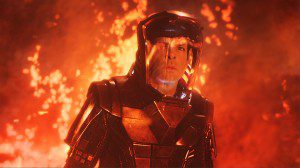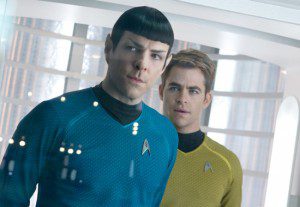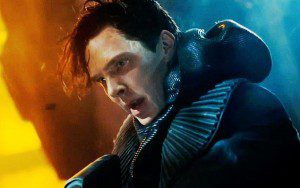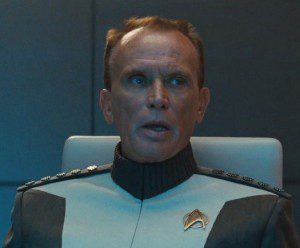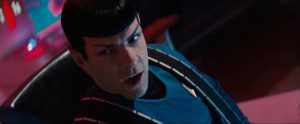 This post has taken a lot longer to write than I expected. I saw Star Trek into Darkness on Wednesday night (the studio, in its wisdom, decided to hold this film back from most critics until the last possible second) and began writing this post on Thursday morning, but life got in the way and I couldn’t finish it all in one sitting — and then, whenever I came back to this post, I found that I had more things to say, or different ways of saying what I had already said, and so on, and so on. But here we are now, on Monday, and the film has finished its first weekend in North America (where it slightly underperformed at the box office), and I am finally going to force myself to finish this thing.
This post has taken a lot longer to write than I expected. I saw Star Trek into Darkness on Wednesday night (the studio, in its wisdom, decided to hold this film back from most critics until the last possible second) and began writing this post on Thursday morning, but life got in the way and I couldn’t finish it all in one sitting — and then, whenever I came back to this post, I found that I had more things to say, or different ways of saying what I had already said, and so on, and so on. But here we are now, on Monday, and the film has finished its first weekend in North America (where it slightly underperformed at the box office), and I am finally going to force myself to finish this thing.
So. Here’s the thing about the J.J. Abrams Star Trek movies: He throws so many things at you, so quickly, that you cannot help but miss some details that are actually fairly important, at least on first viewing.
For example, it wasn’t until the second time that I saw his 2009 “reboot” of Star Trek that I realized virtually all of Kirk’s fellow Starfleet cadets had been killed by Nero, except for the ones who were on Kirk’s ship. As you may recall, Starfleet gets a distress call from Vulcan while Kirk is in the middle of being reprimanded by Starfleet authorities — and the disciplinary hearing is put on hold so that all of the recent graduates can board their ships and fly to Vulcan. When all of the ships go to warp speed, the Enterprise accidentally stays behind, because of an error on Sulu’s part — and when the Enterprise finally gets to Vulcan, it finds nothing but a debris field orbiting the planet. Which, when you think about it, means that everyone on all those other ships — including the green alien roommate of Uhura’s that Kirk slept with — is dead, dead, dead. But by that point, the film has forgotten them and moved on to other things; and then, at the film’s conclusion, everyone at Starfleet Academy cheers when Kirk is promoted to captain. Do they make at least a token nod to the fact that they just lost dozens, if not hundreds, of their classmates? Nope.
So, take anything I say in this post with a grain of salt. I have only seen the new film once, and I may have missed all sorts of stuff that won’t register until a second viewing. (One e-pal has already informed me that the movie refers to an incident from the comic-book prequel Countdown to Darkness, but I completely missed that reference as I was watching the film. And I’ve actually read that comic!)
 First the good half, then the bad half
First the good half, then the bad half
The thing about the movie that stands out to me the most right now is that the first half of the film is actually fairly promising, and seems to be taking the franchise in some new and interesting directions, whereas the second half of the film turns into an increasingly, and presumably unintentionally, self-parodic karaoke remix of previous Star Trek films — and one previous Star Trek film in particular.
This difference between the first and second halves of the film is evident, for example, in how it treats the Spock-Uhura relationship that was introduced in the previous film. Whatever you might make of that twist, it’s now part of the continuity on this new timeline, and the new movie explores their relationship from a few new angles, summed up well by Kirk when he asks Uhura: “Are you and Spock fighting? What is that like?” But this plot thread, which is actually kind of interesting, is pretty much dropped and forgotten by the second half of the film, and Uhura, surprisingly, is almost reduced to just another crewmember by film’s end. (Which is not to say that she and Spock break up or anything; the second half of the film just doesn’t foreground their relationship any more, the way the first half of the film did.)
But perhaps the best way to illustrate the difference between the two halves of the film is to look at two different death scenes — neither of which I’ll spoil, except to say that Spock’s reactions to both deaths are profoundly different. The first time, he witnesses the death in a very hands-on way, which is to say he mind-melds with the dying person at the moment of death — something I don’t believe I’ve ever seen a Vulcan do before — and Zach Quinto’s face as Spock experiences someone else’s dying thoughts is a marvel of subtle, suggestive acting. But during the second death scene, the script calls on Quinto and others in the scene to recycle entire lines of dialogue from a previous film, to the point where I finally had to stifle a laugh — and right at the point when the film was trying to be taken most seriously.
As my friend Betty points out, this film is clearly setting itself up for failure if it tries to evoke comparisons between itself and earlier, better Star Trek films; I have a hard time believing anyone is going to want to remake this film in 30 years the way this film kinda, sorta tries to remake a certain other film. I am reminded of Alfred Hitchcock’s belief that it was better to adapt bad books than good books, or Steven Soderbergh’s recently-expressed belief that studios, instead of remaking classics that can’t really be improved upon, should be looking for “some sort of programmer that was made 50 years ago that has a really good idea in it, that if you put some fresh talent on it, it could be really great.” There are lots of bad Star Trek stories already. So instead of taking a good story and making a bad copy of it, Abrams and company should be looking at some of the bad stories and finding a way to make them great.
Many of the things that annoyed me about Abrams’ previous film are on full display here. One of them is his tendency to put starships on planet surfaces — or, in this case, below a planet’s surface. In the previous film, he posited that the Enterprise was put together not in some sort of spacedock but on the surface of planet Earth — and in Iowa, no less; here, in the film’s opening sequence, he takes things in an even more ridiculous direction by having the Enterprise go underwater for no better reason than to hide from the natives of some primitive planet. But, wait, why hide all the way underwater when you could just stay in orbit? And why are Kirk and McCoy going to and from the natives’ village on foot when they could be taking advantage of the transporter? And why does Spock have to personally take his device into the heart of the volcano that is threatening to destroy that village? If, as the previous film asserted, you can use trans-warp technology to beam someone or something to a ship that is already in warp drive somewhere far away, why couldn’t Spock just beam this device into the nearby volcano?
In the climax to this sequence, Kirk decides to save Spock even though it means violating the Prime Directive, which prohibits Starfleet officers from interfering with the natural evolution of societies that have not yet made it into space; as the Enterprise rises out of the ocean to go save Spock, the natives marvel at it and begin to draw pictures of it in the dirt — suggesting, perhaps, that a new cult will form around the aliens’ memory of this experience. (Interestingly, these aliens are dark-eyed albinos, just like the aliens we saw at the beginning of Prometheus (2012) — which, like Star Trek into Darkness, was produced and co-written by Damon Lindelof. But where the aliens of Prometheus were the “gods” around whom early humans based their cults, it is the humans who are the “gods” this time.)
Most of this sequence was revealed to the public five months ago, when it was shown before IMAX screenings of The Hobbit: An Unexpected Journey, and I have often wondered whether there was a contradiction of some sort inherent to this sequence: on the one hand, Spock says the Enterprise cannot expose itself because that would violate the Prime Directive, and yet, Spock himself is interfering in the planet’s natural evolution by trying to save the natives there — so would not that, itself, violate the Prime Directive, at least according to some interpretations of it? Well, as it turns out, the film is aware of this tension, because when Spock and Kirk return to Earth, they are chewed out by Admiral Pike for both of these violations; the Enterprise was sent to that planet to “survey” it, and not, as Pike says, to “play God” with it.
(Incidentally, if you haven’t seen it yet, check out this post at TrekMovie.com on ‘The Science of Star Trek Into Darkness’. Among other things, it points out that volcanoes are actually less hot than the heat the Space Shuttle orbiters used to face when they re-entered Earth’s atmosphere — so if the Enterprise could survive the latter, there’s no reason the former should have posed any sort of problem. The ash from the volcano, on the other hand, is another matter…)
The question of non-interference is brought up in other ways, too. Much later in the film, Spock decides to contact his older self — the Spock played by Leonard Nimoy, called Spock Prime in these films — and ask him for information that might be helpful. Spock Prime says he took a vow not to reveal anything about his past that might influence the younger Spock’s destiny, but then, “that being said,” he goes on to share some information anyway.
Now, it makes no sense for Spock Prime to hide information about the original timeline, because the new films have already established that the future on this timeline will be very different from the future of that one; and, what’s more, if Spock knows of potential threats to the Federation and refuses to share this information, then he becomes, in some sense, responsible for those threats.
Beyond that, Spock Prime has already brought back the “red matter” that destroyed the planet Vulcan on this timeline, and he has already brought back the trans-warp beaming technology that Scotty used in the previous film — and which, in this film, Starfleet has already adapted to its own purposes — and he has already told the younger Spock that he, young Spock, must become friends with Kirk because it is their destiny to do so. So he has already influenced the destiny of this timeline quite a bit as it is, and there’s really no basis for “vowing” not to influence it any more.
Still, “that being said,” the fact that Spock breaks his vow anyway — and the particular way he breaks it — opens up a whole other can of worms. Instead of liberating the characters to do things differently than they were done before, Spock Prime tells his younger self a story that has the unfortunate effect of turning the second half of this film into a mix-and-match remake of key scenes from Star Trek II: The Wrath of Khan (1982). As my e-pal Nathanael Booth has put it, this is the first film in which the Star Trek characters are actually conscious of themselves as characters in someone else’s story, and in which they begin to do certain things not necessarily for personal character-based reasons, but because it is what the story demands of them.
(Incidentally, thanks to his presence in this film, Nimoy now holds the record for most appearances in a Star Trek movie: of the twelve films made so far, he has appeared in eight. Prior to this, thanks to his appearance in the 2009 film, Nimoy was tied with fellow original-series veterans William Shatner, James Doohan and Walter Koenig, all of whom had appeared in Star Trek: Generations nineteen years ago.)
The question of interference or non-interference — of respecting other people’s boundaries — is raised in other ways, too. On a more obvious level, there is the subplot involving Kirk’s intrusion into Klingon space. But on a subtler level, there is also the way that good guys and bad guys alike want to “use” the Benedict Cumberbatch character, whether by exploiting his intelligence or extracting some of his tissue — and there is something chilling (no pun intended) about the fact that Starfleet just puts him back in storage, as it were, once it is done with him. Nowhere in any of this is his dignity as a person even considered; both sides simply regard him, at different points in the story, as someone — or even something — that they can exploit.
Which brings us to the allegedly mysterious villain played by Cumberbatch himself. So, fair warning: since the film is out there now (and, indeed, has been playing overseas for almost two weeks already), I am going to divulge his true identity here. Don’t read any further unless you have seen the film or don’t mind reading some big-ish spoilers.
One of the first things we learn about this character, who is initially named “John Harrison”, is that he works for Section 31, a shadowy branch of the Federation that has already been around for over a century when this movie takes place. Gene Roddenberry originally envisioned Star Trek as a bright, hopeful depiction of the future in which humanity has worked out most of its major problems — but later writers questioned his utopianism, and Section 31 was one of the results. The organization was first introduced in Star Trek: Deep Space Nine (1993-1999), which takes place one century after the original series, but it was also featured in Star Trek: Enterprise (2001-2005), which takes place one century before the original series — so, in the current continuity, it has always been there. Star Trek into Darkness is simply the first story set in the 23rd century that actually acknowledges this.
But the real question that everybody wants to ask about Cumberbatch’s character is: Who is he really? Is he Khan, or someone else we’ve seen before? And the answer, which turns out to be quite anticlimactic, is: Yes, he is Khan.
In the original TV series, Khan was a genetically-enhanced tyrant from the late 20th century who, along with dozens of his fellow supermen (and superwomen), fled Earth on a “sleeper ship” in suspended animation — and who, a few hundred years later, was woken up by Kirk. In the new timeline, however, Khan was found by Section 31 between the two movies and coerced into working for that organization — and the story proper begins when Khan decides to fight back and destroy Starfleet from within. But of course, it is suggested that Section 31 may be pulling some strings here, and some of the stuff that Khan does to Section 31 plays into their plans, but some of it does not, and I have no idea what sense any of it makes right now.
The bigger issue for me, given that I’m a continuity nut and all, is that the film makes some changes to the Khan back-story that don’t match what we saw in the earlier stories, where he was played by Ricardo Montalban. (Montalban, incidentally, brought a certain charismatic playfulness to Khan that is utterly missing from Cumberbatch’s performance — and I don’t think this personality change can be blamed entirely on the fact that Cumberbatch’s Khan has spent a year working for Section 31. Also, Cumberbatch recites some of his lines in a sort of breathy, menacing tone that reminds me of Dana Carvey’s parody of Khan on Saturday Night Live more than it does the villain himself. But I digress.)
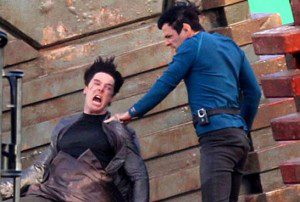 For one thing, Khan is now way more strong than he was before. In ‘Space Seed’, the episode that introduced Khan and his fellow superhumans way back in 1967, Spock knocked one of them out with his Vulcan nerve pinch, while Kirk was able to defeat Khan himself by hitting him several times with some sort of tool that he pulled out of a wall. But that wouldn’t work on the Khan we see in this film, who is basically impervious to physical blows and Vulcan nerve pinches alike (though the latter do seem to hurt him, at least). What’s more, he cannot even be knocked out by a phaser stun blast! And then there’s that weird magical healing power that is now attributed to his blood cells.
For one thing, Khan is now way more strong than he was before. In ‘Space Seed’, the episode that introduced Khan and his fellow superhumans way back in 1967, Spock knocked one of them out with his Vulcan nerve pinch, while Kirk was able to defeat Khan himself by hitting him several times with some sort of tool that he pulled out of a wall. But that wouldn’t work on the Khan we see in this film, who is basically impervious to physical blows and Vulcan nerve pinches alike (though the latter do seem to hurt him, at least). What’s more, he cannot even be knocked out by a phaser stun blast! And then there’s that weird magical healing power that is now attributed to his blood cells.
Then there is the question of what role Khan played in human history. In ‘Space Seed’, Khan was one of about 40 genetically-enhanced dictators who fought each other in the 1990s, and Khan was remembered by Kirk and his crew as “the best of the tyrants”, to the point where Scotty could even say, “I’ve always held a sneaking admiration for this one. . . . There were no massacres under his rule.” But in Star Trek into Darkness, the young Spock, apparently working with information that Spock Prime has given him, accuses Khan of committing “mass genocide” against people he believed to be “inferior” to him. That seems like a discrepancy to me.
(Interestingly, both ‘Space Seed’ and The Wrath of Khan specified that Khan had lived on Earth “two hundred years ago”. But the original series was set in the 23rd century, and Khan came from the 20th century, so this was always a bit of an anomaly. Star Trek into Darkness corrects this by specifying that Khan is actually three hundred years old — which, given that this film takes place in 2259, would seem to mean that Khan and his genetically-enhanced body, with its magical healing blood, have been around since about 1959. But never mind that for now.)
Beyond this, Spock Prime tells his younger counterpart that Khan was the “most dangerous adversary” faced by the original Enterprise, but that hardly seems accurate, given that Kirk did defeat Khan in a hand-to-hand fight. Surely the Greek god Apollo, or one of the planet-ruling computers, or one of Kirk’s other adversaries was more dangerous than Khan turned out to be. He may have killed more of Kirk’s crew — including Spock himself — than any other adversary in the end, but that hardly means he was the worst of the lot. (For one thing, most of Kirk’s crew in The Wrath of Khan were mere cadets, so Khan had a bit of an advantage there. As Scotty puts it, one of the reasons Khan’s first attack was so successful was because “the trainees ran”.)
The new film also plays quite strongly on the notion that Khan is emotionally attached to his fellow superhumans; the film wants to humanize Khan, or make him more sympathetic, by showing that he cares for his “family” the same way Kirk cares for his crew. Khan certainly did feel an emotional attachment to his followers in the previous stories; this was most evident, perhaps, in the scene from The Wrath of Khan where Khan cradles Joachim’s dying body and promises to avenge him — thereby missing the fact that Joachim’s dying words were an implicit critique of Khan’s thirst for vengeance, which had clouded his thinking and led to Joachim’s death itself. But I wonder if Star Trek into Darkness overplays this emotional connection. In both ‘Space Seed’ and The Wrath of Khan, Khan unilaterally sets in motion a self-destruct sequence that will kill both him and any of his followers who might still be alive, just so that he can kill Kirk and his crew in the process; rather than admit defeat, he’s prepared to kill everyone, friend and foe alike, just to satisfy his ego. And I don’t think that aspect of the character comes across in the new film very well, if at all.
Of course, emotional connections are what the Abrams films are all about — especially those of the boyfriend-girlfriend, parent-child sort. The last film gave us Kirk wrestling with the fact that he never knew his father and Spock wrestling with the death of his mother, and it also introduced us to the Spock-Uhura relationship. The new film adds to the mix by underscoring the relationship between Kirk and Admiral Pike, who comes across as more of a father figure here than he did in the previous film (I think he even calls Kirk “son”; did he do that in the last film?), and by giving Carol Marcus a father, Admiral Marcus, who she addresses at one point as “Dad” — a word that I think has been used only once before in a Star Trek film, when Dr McCoy has a flashback to the death of his father in Star Trek V: The Final Frontier (1989). (Spock, for his part, has called his parents “Father” and “Mother”; and when David Marcus addressed Kirk in Star Trek III: The Search for Spock (1984), he called him “Sir”.) Put simply, there’s a sense in which the Abrams films are more adolescent in sensibility than earlier incarnations of this franchise.
You had feelings of friendship and loyalty in the original series, of course, but there was always a sense that these characters were about something more than that: there were principles and ideals at stake. One of my favorite moments in the entire franchise comes near the end of Star Trek IV: The Voyage Home (1986), when Sarek tells Spock, “Your associates are people of good character,” and Spock replies, “They are my friends,” as if to say that true friendship, of the sort that these characters had formed over the decades, is rooted in something like “good character”.
In the Abrams films, on the other hand, friendship trumps principles, ideals, and just plain good sense. In the 2009 film, Spock Prime knows that a major threat is heading for Earth, and he knows what to do about it, but he refuses to accompany young Kirk back to the Enterprise because of some strange idea that this would interfere with the nascent friendship between Kirk and young Spock. And in the new film, Kirk justifies his violation of the Prime Directive on a similar basis, by indicating that friendship — even to someone he has known for only a year or so — was more important to him than the principles that have been guiding the Federation for decades.
I hope I’m not overstating the case here. Kirk certainly broke the rules to help his friends in, say, The Search for Spock — though even there, he did so after appealing to concepts such as “loyalty” and “sacrifice” — and in the original series, he certainly found some wriggle room around the Prime Directive whenever it suited him; he was especially fond of arguing that it was okay to interfere when a society was in stasis, such as on certain planets that were controlled by computers, because the Prime Directive only applied to “living, growing cultures.” So there has always been some negotiation, as it were, over when to follow the rules and when to break them.
But my main point here is that the negotiation is very one-sided in the Abrams films, to the point where it doesn’t really feel like a negotiation at all. And I think the difference in sensibility can be summed up best by a recent interview in which Abrams apparently misquoted something that Shatner said about his films. Shatner said Abrams was a “great filmmaker” but the original Star Trek had “more soul”, and Abrams, commenting on this a few months later, said Shatner had given him “a fantastic underhanded compliment” by saying that the 2009 film “was a fun action ride and maybe one day it’ll have heart.” Where Shatner said “soul”, Abrams heard “heart”, and while the difference between the two words may be a subtle one, I think it’s telling that Abrams’ brain filtered Shatner’s words the way it did.
Following on the notion that Abrams’ Star Trek films have neglected higher themes and principles… Many people, myself included, complained that the 2009 film was the first in the series that wasn’t really about anything other than franchise perpetuation; David Poland, if memory serves, said it was the first Star Trek movie that didn’t have a “Big Idea”. Star Trek into Darkness seems to be trying to correct for that by introducing explicitly political elements that hark back to recent and current events, just as, say, Star Trek VI: The Undiscovered Country (1991) played on the then-recent (if not then-current) thawing of the Cold War. The new film even goes so far as to conclude with a dedication to post-9/11 military veterans.
But what, exactly, is the political framework here? I’ve already mentioned how the film brings Section 31, that shadowy branch of the Federation, into the 23rd century. But this film goes even further, it seems to me, by casting Admiral Marcus as an outright villain who is prepared not only to sacrifice Starfleet’s newest flagship by exposing it to the Klingons (a la the way King David ordered Joab to expose Uriah in battle), but to destroy it outright, along with all its hundreds of crewmembers. As some critics have rightly noted, if the story told by this film is meant to be a commentary on current events in any way, shape or form, then it is essentially endorsing a “Truther” version of history, in which the real villains are not just bellicose politicians who lie and exaggerate to justify military action, but conspirators who actively kill their own citizens on their own turf as a pretext for war.
Critics of “Trutherism” have sometimes asked how people who supposedly believe such awful things about their leaders can go on living in countries run by those authorities — if they truly believe those theories, that is. Likewise, it seems to me that Star Trek into Darkness suggests such awful things about the highest authorities in the Federation that there really ought to be more fallout than we see here. But instead, no, we get an epilogue that jumps ahead a year or so, in which the Enterprise is repaired (and slightly redesigned) and Kirk is ready to set off on his first five-year mission. Just as the 2009 film “forgot” all about the dead classmates, this film wants us to “forget” certain things, too — like the fact that Section 31’s newest military-grade starship crashed into the Federation’s capital city and knocked over countless skyscrapers, no doubt killing thousands of people. The end of the film would have you believe that everything is back to normal a year later, and Kirk can go off and explore deep space, safe in the knowledge that his home planet is just fine. Really?
So many characters get cut and bruised during the fist-fights in this film that I began to wonder if the filmmakers would remember to make sure that Spock’s blood is green. And sure enough, thank goodness, when Spock fights Khan on the barges at the end of the film, the blood he bleeds is green, indeed.
Once again, Abrams recycles elements that were first introduced in Star Trek: Nemesis (2002). In the 2009 film, it was starships getting hit by space debris and people getting sucked out of breaches in the hull. In this film, it’s the seatbelt that automatically extends over the captain’s chair (and others). While that detail did not appear in the final theatrical version of Nemesis itself, it was included in a deleted scene that would have appeared at the very end of the film.
The Enterprise has a new science officer this time who is linked to the ship’s computer via a cybernetic implant in his head; the actor who plays him calls this officer an “augmented human”. This is deeply ironic, since Star Trek has always been skeptical of efforts to “augment” humans — and the prime example of this is Khan himself, whose official species classification is “Human Augment”.
In the TV shows, genetic engineering is prohibited within the Federation as late as the 24th century; as someone put it in an episode of Deep Space Nine, which revealed that Dr Bashir had received some illegal genetic enhancements in his youth, “for every Julian Bashir that can be created, there’s a Khan Singh waiting in the wings.”
But perhaps cybernetic implants are less problematic, even though they look rather Borg-like? Star Trek has certainly made its peace with artificial intelligence in general, arguing in shows like Star Trek: The Next Generation (1987-1994) and Star Trek: Voyager (1995-2001) that artificial beings like Data and the holographic Doctor are sentient lifeforms with all the same rights that we have. But has Star Trek ever looked positively at the fusion of the organic and the artificial, at least when it comes to the brain or the mind? I can’t think of any examples, except for the V’Ger-Decker fusion at the end of Star Trek: The Motion Picture (1979) — but even there, we never get to see the fusion once it has happened. Star Trek writers, it seems, can accept the idea of a human-machine merger in theory, but they don’t know how to incorporate it into the characters’ everyday lives. Or, rather, they didn’t, until Abrams came along.
Speaking of artificial lifeforms, I am amused that Kirk calls Spock a “robot” for sticking to the rules so absolutely. This kind of harks back to a theme I explored back when Star Trek: Insurrection (1998) came out: in that film, the characters are about to rebel against their superiors in Starfleet, and they turn to the android Data for moral justification, convinced that the “ethical and moral subroutines” in his programming will be an infallible arbiter of “right and wrong”. But that just begs the question: who programmed those subroutines, and how moral is he?
I am also struck by the scene in which Scotty marvels at how things have fallen apart on the Enterprise after he’s been gone for only “one day”. Remember, this film includes flights from Earth to Qo’noS and back again — and in The Motion Picture, it was established that the even shorter flight from Earth to Vulcan takes four days, so these other flights should presumably be taking even longer.
Finally, I think I counted at least four uses of the word “shit”, which nearly ties all previous uses of that word in all of the previous films combined: Kirk repeats Gillian’s use of “dipshit” in The Voyage Home, where the joke was that no one in the 23rd century uses those kinds of words any more; Data says “Oh, shit!” in Generations, as the Enterprise-D plummets to its doom; Lily Sloane, a 21st-century character, says “bullshit” twice when talking to Picard in Star Trek: First Contact (1996); and Kirk says “bullshit” once when Spock Prime identifies himself in the 2009 film.
I don’t necessarily object to the presence of profanity in this film, or to the presence of profanity in Abrams’ depiction of the 23rd century. Given that words like “shit” have been around for centuries already, it always seemed unlikely to me that it would vanish in the relatively near future. But previous films used the word sparingly, for comic or dramatic effect, and there’s something about the casual use of it in this film — and in recent entries in other franchises that had previously avoided such language, such as the James Bond film Skyfall (2012) — that is worth noting, I think.
And… that’s about all I can think of without checking my notes. Ah well, this post is far too long as it is. So, these are my first impressions of Star Trek into Darkness. Who knows what a second viewing might turn up.


